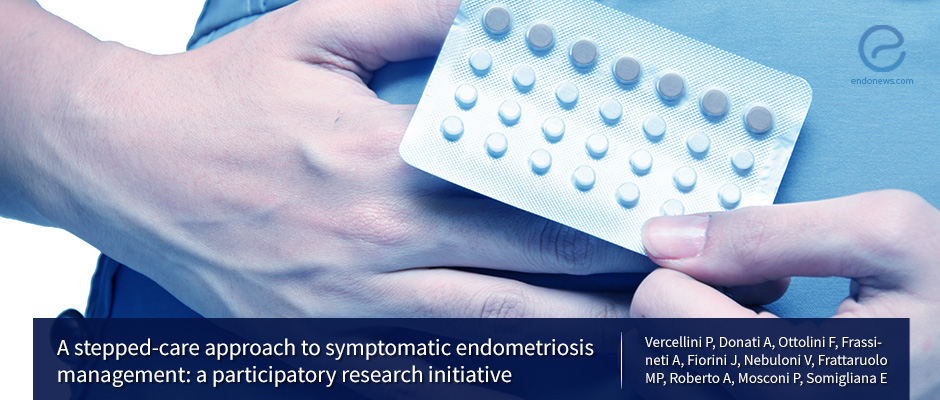Oral Contraceptives and Low-Cost Progestins to Reduce Endometriosis-Associated Pain
Jul 5, 2018
Moving to high-cost progestins or surgery may not be necessary to reduce pain for most women with endometriosis.
Key Points
Highlights:
- Oral contraceptives and low-cost progestins may be enough to reduce the pain of most women with endometriosis.
Importance:
- The results of the study suggest that it may not be necessary for most women with endometriosis-associated pain to use high-cost progestins or undergo surgery to reduce their pain symptoms.
What's done here:
- Researchers in Italy enrolled women with symptomatic endometriosis on a stepped-care treatment protocol and assessed whether they were satisfied with their treatment.
Key results:
- 106 out of 157 women were still using oral contraceptives after one year; 23 out of 157 women were using norethindrone acetate (NETA), a low-cost progestin
- Only 3 of 157 women had moved to the high-cost progestin during the one-year treatment period because the other treatments failed to reduce symptoms or they were not tolerating them.
- 4 out of 157 women had undergone surgery
- The overall satisfaction rate with the stepped-care protocol was 62 percent.
- Significant improvements were observed in all pain symptom and women’s quality of life both physically and mentally, after one year of treatment.
- The sexual functioning of the women did not vary substantially.
Limitations:
- Because the women in the study decided to take part in the stepped-care protocol themselves, they were already favoring hormonal therapy rather than surgery and are not representative of the general population of women with endometriosis.
- The personnel of the study center may have had a psychological effect on the participants when discussing the benefits and harms of the different treatment options available and this may have influenced their decision.
- The patient numbers are not satisfactory for high statistical power.
Lay Summary
Most women with endometriosis-associated pain did not feel the need to use expensive progestin or undergo surgery. Instead, they were satisfied with a low-cost progestin to treat their symptoms. This is according to a study published in the journal Fertility and Sterility.
These results are important because they suggest that low-cost progestins may constitute a “high-value care” option for the management of endometriosis.
In order to assess whether patients with symptomatic endometriosis were satisfied with the medical treatment they received, researchers in Italy conducted a prospective, single-arm, self-controlled study in 157 women with symptomatic endometriosis. They gathered detailed information on the women’s medical and surgical treatment. They started all women on a step-care protocol, which included three subsequent medical treatment steps: oral contraception, 2.5 mg per day of norethindrone acetate (NETA), and 2 mg per day of dienogest (DNG), as well as a surgery step. Women moved to the next step if the treatment they received was ineffective in controlling their symptoms or if they were intolerant to it.
The researchers assessed the women’s satisfaction with their treatment a year after starting the step-care protocol using a five-category scale: very satisfied, satisfied, neither satisfied nor dissatisfied, dissatisfied, and very dissatisfied. Researchers also measured the pain symptoms of the women using a numeric rating scale from 0 to 10 with 0 corresponding to no pain and 10 to the highest possible pain. In addition, they assessed women's quality of life using the short form 12 questionnaire (SF-12), and their sexual functioning using the female sexual function index (FSFI).
They found that one year after the start of the step care protocol, 106 women (67.5 percent of all women) were still using oral contraceptives, I.e. were in the first step of the step-care protocol. A total of 23 women (14.6 percent) were in the second step and were using NETA. Only three women (less than two percent of all women) were in the third step of the protocol and were using DNG. A total of four women had undergone surgery while 21 (13 percent) dropped out of the study Five of those left the study because they wanted to become pregnant. Apart from the women who left the study to become pregnant, 95 (62 percent) were satisfied with the step-care protocol.
When they analyzed the results of the pain scores, SF-12 questionnaire, and the FSFI, the researchers found that there were significant improvements in pain symptoms and physical and mental well-being of women. The women’s sexual functioning scores did not change one year after starting the step-care protocol.
“Most women with endometriosis-associated pelvic pain who chose a stepped-care approach were satisfied with oral contraceptives and a low-cost progestin [NETA] for the treatment of their symptoms,” the researchers wrote. They also noted that the need to step up to an expensive progestin or surgery was marginal.
Research Source: https://www.ncbi.nlm.nih.gov/pubmed/?term=29871796
Oral contraceptives low-cost progestins high-cost progestins pain drug treatment surgery quality of life sexual functioning

